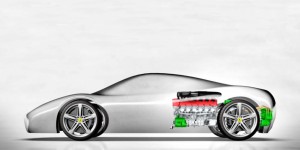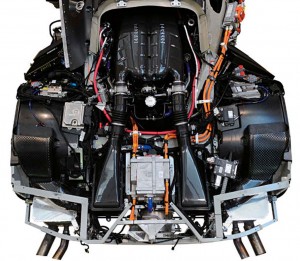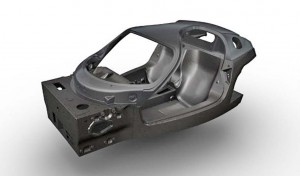
An image from Ferrari shows how the V-12 and HY-KERS hybrid system will fit inside the new supercar debuting in Detroit next January.
Mention hybrids and most folks will likely picture a slow and staid automobile whose primary advantage is fuel efficiency. But a new Ferrari, codenamed F150, is likely to change that perception.
And, no, that’s not the Italian maker’s first-ever truck. F150 is internal code for what is expected to be the successor to the legendary Ferrari Enzo. What name it will use in the showroom remains a top secret but Italian media are speculating it could be the F70.
Based on an ultra-light carbon fiber chassis, the new model is expected to pack a 900-horsepower drivetrain into its engine bay, a powertrain pairing a V-12 gasoline engine and a lithium-ion-based hybrid system.
To put things into comparison, that’s nine times more than the standard Toyota Prius and seven times more than the bigger Prius V. Measured another way, Ferrari has revealed the F150 will make about 0.61 horsepower per pound of weight, one of the best power-to-weight ratios ever seen, so 0 to 60 times could be at least four times faster than that of your everyday hybrid.
Korean manufacturer Samsung will reportedly supply the lithium-ion battery pack. Its precise size has not yet been revealed but it’s expected to be wrapped in Kevlar to ensure its safety and will be mounted in the center of the vehicle, between driver and passenger, somewhat like the approach in the Chevrolet Volt or Fisker Karma.
The entire hybrid system is expected to weigh in at just over 300 lbs. including motor and batteries, mass Ferrari will try to offset with the extensive use of carbon fiber and other engineering tricks. Company officials plan to use the same production method adopted for building Formula One race cars rather than the process favored for other carbon fiber vehicles, such as the McLaren MP4-12C.
The F1-derived HY-KERS systems is expected to add another 10% to the power of the V-12 while also reducing CO2 emissions 40%. (HY-KERS, incidentally, is shorthand for Hybrid Kinetic Energy Regeneration system.)
That will be a particular important breakthrough for the supercar maker. Like all other manufacturers, Ferrari will be facing increasingly tough new standards on CO2 emissions in Europe and tightened mileage requirements in the U.S.
Ferrari is expected to introduce a number of improvements to its V-12, as well, including a multi-spark ignition system and continuous variable-length inlet ducts. A 7-speed multi-clutch gearbox, the maker says, will be integrated with the Hy-KERS motor drive to maintain its conventional size and shape.
In this image of the next-gen Ferrari Enzo’s engine bay, electrical wiring can be seen in orange – a signal used to help service techs and emergency responders quickly decode which wiring is carrying high voltage.
Ferrari offered a first look at the new ultra-car’s chassis during the recent Paris Motor Show. And when asked whether the new model might again carry the name Enzo, Ferrari CEO Luca di Montezemelo demurred, suggesting only that, “You can be sure it will not be called ‘Luca.’”
The maker’s first true ultra-car was the F40, released in 1987 to celebrate the Ferrari brand’s 40th anniversary. The F50 followed a decade later. Then came the limited-edition Enzo, named in honor of the prancing pony marque’s founder. Many expect the new model to be named the F70, though the next big anniversary is still five years away.
Ferrari plans to reveal the complete prototype of the F150 project at the Detroit Auto Show next January. But it remains uncertain exactly when the hybrid will be ready for market. One thing most sources agree on is that it will carry a price tag well in excess of $1 million.
Ferrari, incidentally, isn’t the only maker that sees a performance side to electric propulsion. Audi is working up a plug-in variant of its R8 2-seater while Jaguar plans to seek more than $1 million for the hybrid CX-75. And the long-awaited successor to the Acura NSX will use a new three-motor hybrid driveline. Mercedes-Benz, which has also been tinkering with hybrids, nonetheless is going the pure battery-electric route with the new SLS AMG E-Cell it revealed at the Paris Motor Show a few weeks ago.


